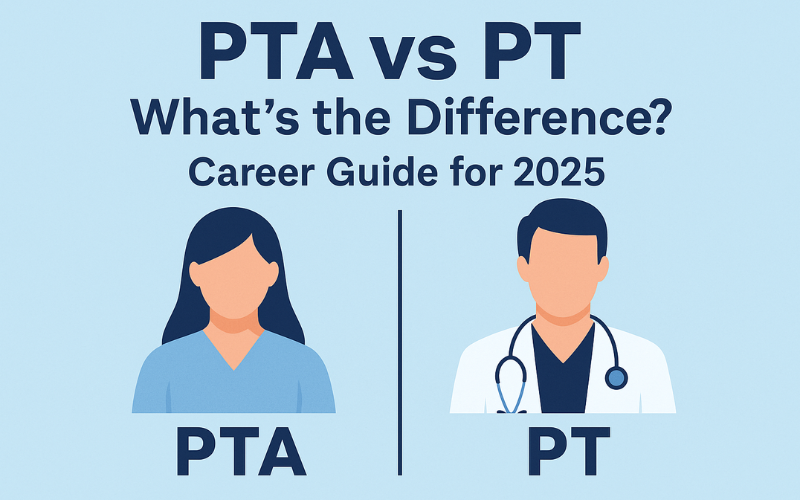Are you thinking about a job in physical therapy but not sure if you should become a PTA or a PT? You’re not alone. Many people ask the same question: What’s the difference between a Physical Therapist Assistant (PTA) and a Physical Therapist (PT)?
In this easy-to-follow guide, we’ll break down the key differences in schooling, job duties, salary, and career growth in 2025. Whether you’re just starting out or looking to change paths, this post will help you decide which role fits your goals—and your lifestyle. Let’s dive in!
Table of Contents
🚨 Before you continue! 👉 Check out my latest blog: Top 3 Exercises for Lumbar Spinal Stenosis Relief or other related posts throughout this site.
What’s the Difference Between a PTA and a PT?
If you’re exploring a career in physical therapy, one big question probably comes to mind: What’s the difference between a PTA and a PT?
While both careers work closely with patients to help them recover from injuries and improve movement, their roles, responsibilities, education requirements, and salaries are quite different.

Let’s break it down simply:
🔹 1. What is a Physical Therapist (PT)?
A Physical Therapist is a licensed healthcare professional who:
- Evaluates patients
- Diagnoses movement issues
- Creates full treatment plans
- Makes clinical decisions
- Supervises PTAs and other support staff
🚨PTs must earn a Doctor of Physical Therapy (DPT) degree, which usually takes 7 years total (4 years undergrad + 3 years grad school).
🔹 2. What is a Physical Therapist Assistant (PTA)?
A Physical Therapist Assistant works under the supervision of a PT. Their job includes:
- Helping patients perform exercises
- Giving certain treatments (like ultrasound or stretching)
- Tracking patient progress
- Reporting back to the PT
🚨PTAs need a 2-year associate degree from an accredited program and must pass a national licensing exam.
🔍 Quick Comparison: PT vs PTA
| Category | PT | PTA |
|---|---|---|
| Education Length | ~7 years (Doctorate required) | ~2 years (Associate degree) |
| Can Diagnose? | Yes | No |
| Can Create Treatment Plan? | Yes | No |
| Average Salary (2025 est.) | $98,000+ | $60,000+ |
| Supervision Required | No | Yes (must work under a PT) |
Education Requirements: PTA vs PT
One of the biggest differences between a PTA and a PT is the amount of education needed before starting your career.

🎓 How Long Does It Take to Become a PT?
To become a Physical Therapist, you’ll need to:
- Earn a 4-year bachelor’s degree (usually in a science-related field like biology or kinesiology)
- Complete a Doctor of Physical Therapy (DPT) program, which takes about 3 years
- Pass the National Physical Therapy Exam (NPTE)
Total time: About 7 years
DPT programs are competitive and often include clinical rotations, lab work, and hands-on patient care. Many students also graduate with student loan debt due to the high cost of graduate school.
🧾 How Long Does It Take to Become a PTA?
To become a Physical Therapist Assistant, you’ll need to:
- Complete a 2-year associate degree from a CAPTE-accredited program
- Pass the National PTA Exam
Total time: About 2 years
PTA programs are shorter, more affordable, and often include internships in outpatient clinics, hospitals, or rehab centers. This path is ideal if you want to start working sooner.
📘 Side Note: Accreditation Matters
Always choose a program accredited by CAPTE (Commission on Accreditation in Physical Therapy Education). This is required to sit for licensing exams in most states.
PTA vs PT Salary and Job Outlook in 2025
Salary and job growth are key factors when choosing between becoming a PTA or a PT. Let’s compare how much you can expect to earn and how secure each career path looks in the coming years.

💰 How Much Do PTs Make in 2025?
In 2025, Physical Therapists (PTs) earn an average salary of about $98,000–$105,000 per year, depending on location and experience.
Top earners in specialized settings like home health or private practice can make over $120,000 annually.
💰 How Much Do PTAs Make in 2025?
Physical Therapist Assistants (PTAs) make around $60,000–$65,000 per year on average. Some PTAs in high-demand areas or settings (like outpatient ortho or skilled nursing) may earn up to $75,000+ with experience.
📈 Job Outlook: PT vs PTA
According to the U.S. Bureau of Labor Statistics:
- PT jobs are expected to grow by 15% from 2022–2032
- PTA jobs are expected to grow by 19% over the same time period
Both careers are growing much faster than average, making them strong options for long-term job security.
🗺️ High‑Paying States for PTs and PTAs
For Physical Therapists (PTs)
- Darker‑shaded states like California, Nevada, Alaska, New Jersey, and Texas offer the highest average salaries (~$106K–$114K) 🔗See Here
For Physical Therapist Assistants (PTAs)
- States such as Nevada, California, Texas, Georgia, and Massachusetts rank among the top earners for PTA roles (> $71K annually) 🔗See Here
💡 Why Geography Matters:
- Cost of living: High pay in urban states often aligns with higher living costs.
- Local demand: States with aging populations and more clinics often pay more.
🔑 Key Takeaways:
Both roles are in high demand, especially in aging populations
PTs earn more, but require more schooling and often more debt
PTAs earn less, but start working sooner and with less financial risk
Roles and Responsibilities Compared: PTA vs PT
While PTs and PTAs work closely together, their daily duties are very different. Understanding what each role does can help you decide which career fits your interests and strengths.
🩺 What Does a Physical Therapist (PT) Do?
A Physical Therapist is responsible for:
- Evaluating patients’ movement, strength, and pain levels
- Diagnosing physical problems
- Creating full treatment plans based on goals and medical needs
- Making clinical decisions about how care should change over time
- Educating patients and families about recovery and prevention
- Supervising the care provided by PTAs and support staff
PTs take the lead in patient care and carry more legal and clinical responsibility. They must document treatment plans and adjust them as the patient progresses.
🤝 What Does a Physical Therapist Assistant (PTA) Do?
A Physical Therapist Assistant helps carry out the treatment plan created by the PT. Their duties include:
- Guiding patients through exercises
- Providing treatments like stretching, ultrasound, or electrical stimulation
- Observing patient progress and reporting back to the PT
- Helping patients stay motivated during rehab
- Assisting with patient education (as directed by the PT)
PTAs focus on the “hands-on” part of therapy. They cannot change the plan of care, diagnose problems, or work independently from a PT.
✅ PT vs PTA: Who Does What?
| Task | PT ✅ | PTA ✅ |
|---|---|---|
| Evaluate and diagnose patients | ✅ | ❌ |
| Create treatment plans | ✅ | ❌ |
| Carry out treatment sessions | ✅ | ✅ |
| Supervise other staff | ✅ | ❌ |
| Report on patient progress | ✅ | ✅ |
| Adjust care plan as needed | ✅ | ❌ |
🧠 Tip:
- If you enjoy leading, problem-solving, and decision-making, PT might be a better fit.
- If you love working directly with patients and being active all day, PTA could be your path.
Which Career Path Is Right for You?

Now that you know the main differences between a PTA and a PT, it’s time to decide which path fits your life, goals, and values.
Ask yourself the questions below to help guide your decision:
❓ How much time can you invest in school?
- If you’re ready for 7+ years of school and a doctorate degree, PT may be right for you.
- If you want to start working in 2 years, PTA is a faster way to enter the field.
❓ What’s your budget for education?
- PT school is more expensive and often means student loans of $100,000+.
- PTA programs are shorter and more affordable, with much less debt.
❓ Do you want to lead or support?
- PTs lead the rehab process, make decisions, and supervise care.
- PTAs support the PT’s plan, work hands-on with patients, and report progress.
❓ What kind of work-life balance do you want?
- PTs often work longer hours and take on more responsibility.
- PTAs can enjoy more flexibility and less paperwork while still making a big impact.
✨ Good Fit for PT:
- You love problem-solving and clinical leadership
- You want to specialize or open your own practice
- You’re okay with longer school and higher costs
✨ Good Fit for PTA:
- You want to start your career quickly
- You enjoy working directly with people every day
- You want a steady job with less stress
Conclusion: PTA vs PT — Which One Will You Choose?
Choosing between a PTA vs PT career isn’t always easy, but now you have the facts.
Both roles are rewarding, high-demand careers in the world of physical therapy. Whether you want to lead treatment as a PT or work hands-on with patients as a PTA, there’s no wrong choice—just the right fit for you.
Think about your timeline, education goals, finances, and the kind of work you want to do every day. That’s the best way to choose a path you’ll love.

Explore accredited PTA and PT programs near you
To explore accredited PTA (Physical Therapist Assistant) and PT (Physical Therapist) programs near you, these are the best and most reliable websites:
🔍 1. CAPTE Directory – [Commission on Accreditation in Physical Therapy Education]
Website: https://www.capteonline.org
- Why it’s the best: This is the official accrediting body for PT and PTA programs in the U.S.
- What you can do:
✅ Search for accredited PT and PTA programs by state or zip code
✅ Filter by degree type (DPT, Associate)
✅ View program contact info, website, and accreditation status
🌎 2. APTA’s ChoosePT.com – [American Physical Therapy Association]
Website: https://www.choosept.com
- Why it’s useful: Offers a student section with resources on careers, schooling, and program searches.
- Great for exploring the profession and understanding what PT/PTA roles look like day-to-day.
🧭 3. College Navigator – [National Center for Education Statistics]
Website: https://nces.ed.gov/collegenavigator
- What makes it different:
✅ Federal database for all U.S. colleges and training programs
✅ Find tuition costs, financial aid, student loan stats
✅ Search by “Physical Therapist Assistant” or “Physical Therapy/Therapist” majors





